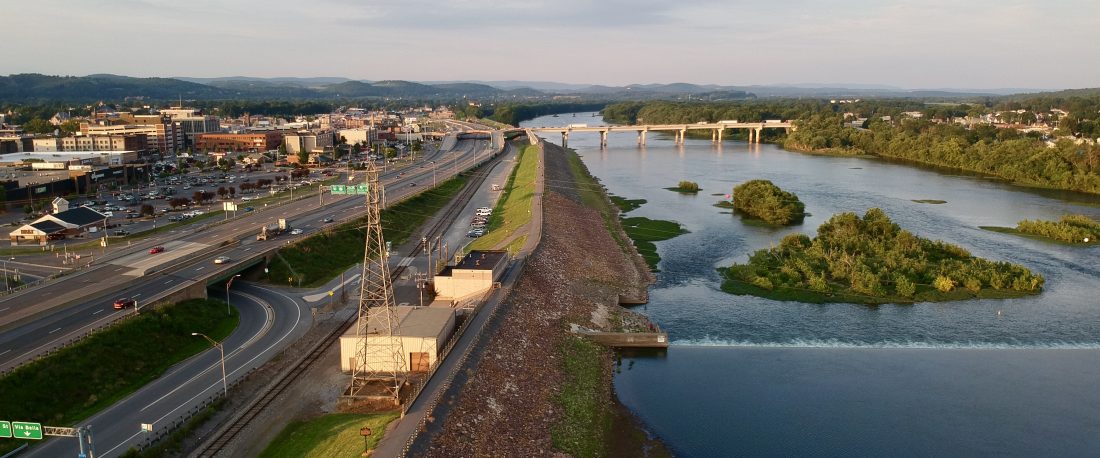

SUN-GAZETTE FILE PHOTO
Projects aimed at rehabilitating the county’s levee systems will be receiving $4 million in American Rescue Plan Act (ARPA) funds, according to the preliminary budget announced this week by the Lycoming County Commissioners.
“There’s $4 billion worth of industry behind that levee system,” said Commissioner Scott Metzger, emphasizing the importance of maintaining the system which protects areas in the city, South Williamsport and Loyalsock Township from flooding.
“There’s 80% of our employment based behind that levee system. There’s 80% of our tax revenue behind that levee system. So, it’s vital that we get this done,” Metzger said.
“The fact that we’re committing $4 million today from our ARPA monies — the county committed a million dollars prior to that. The $5 million from the county shows that we have skin in this game and we take this seriously. We want to see this work get completed,” Metzger said.
Shannon Rossman, executive director of the county’s planning and community development department, also noted the importance of maintaining the levee system.
“We have three levee systems. We have South Williamsport. We have Williamsport — they have two individual levees, but they’re combined. And then we have the Bull Run levee. Behind Bull Run alone, we have almost $120 million in assessed value. That’s the Golden Strip,” Rossman said.
“Because we’ve been doing projects together with the City of Williamsport and South Williamsport which also includes parts of Loyalsock Township, and the Faxon area and Old Lycoming, we have almost $950 million of assessed value behind there, and these are a little dated, so that’s probably closer to a billion,” Rossman said.
She noted that there are 4,500 residences behind the county’s levee system.
Referring to the destruction from Hurricane Ian in Fort Myers, Florida, Rossman said, “You saw the pictures of Fort Myers, you know 4,500 residences that will be affected if our levees, our three levees did not function.”
Following months of seeking input from community groups and deliberating, the commissioners announced the most recent allocations of the $22 million the county had received from the federal government in ARPA funds. The commissioners had received $79 million in requests for the funds.
A prime concern the commissioners had expressed in the process was that the allocations would be generational, serving county residents for generations to come.
“The odds of us getting this type of funding again are pretty low,” Rossman said.
Another concern in deciding where the funds would be distributed was the amount of regulations that are attached to federal funding.
“Sometimes we’ve not been able to use those funds because of the regulations themselves, but we think we’ve come up with a great initial plan for the money,” Rossman said.
Of the initial $22 million, the commissioners put $10 million into payroll convenience. This makes it easier for the commissioners to allocate that funding to different projects listed as bullet points.
The initial $22 million budget is as follows:
1. Payroll Convenience: $10 million
• County Projects: $4 million
• Levee: $4 million
• Municipal Public Safety: $1 million
• Agriculture: $1 million
2. Workforce Development / Private & Public Revenue Loss: $1.3 million This is for those entities and businesses that need to have a resilient workforce and also had difficulty either raising funds or suffered revenue loss during the pandemic
3. Economic Development/Const.: $1 million These are possible grants for eligible entities to assist with construction that would spur economic development and also affordable housing.
4. Public Works: (water and sewer/stormwater): $5 million
5. Early Childhood/Education: $1.1 million for possible grants to help with daycare staffing, with training of teachers and maybe with assistance to the County Library System. Things that are involved in early childhood education.
6. Recreation: $900,000 for projects such as the Riverwalk and other regional projects.
7. Public Health Response: $1.7 million for such things as building designs issues, HVAC, air circulation — things that became apparent because of the pandemic.
8. Broadband: $1 million
Spinoff programs that were directed to other funding sources: Volunteer Fire Company grants, $560,000, COVID Relief Block Grants; and the Housing Starts initiative, $4 million, Act 13 funds.
Rossman said that some requests were directed to other funding sources such as the Department of Conservation and Natural Resources and Community Development Block Grants in order to get the most out of the ARPA funds.
“Things are going to move and flow a little bit depending on the need and specifically the ability to meet ARPA regulations,” Rossman said of the preliminary budget.
“All these things are generational that are going to be impacting generations of our citizens in this county for years to come,” Metzger said.






